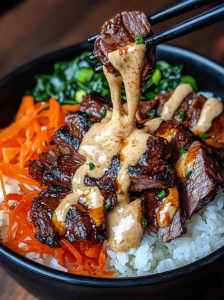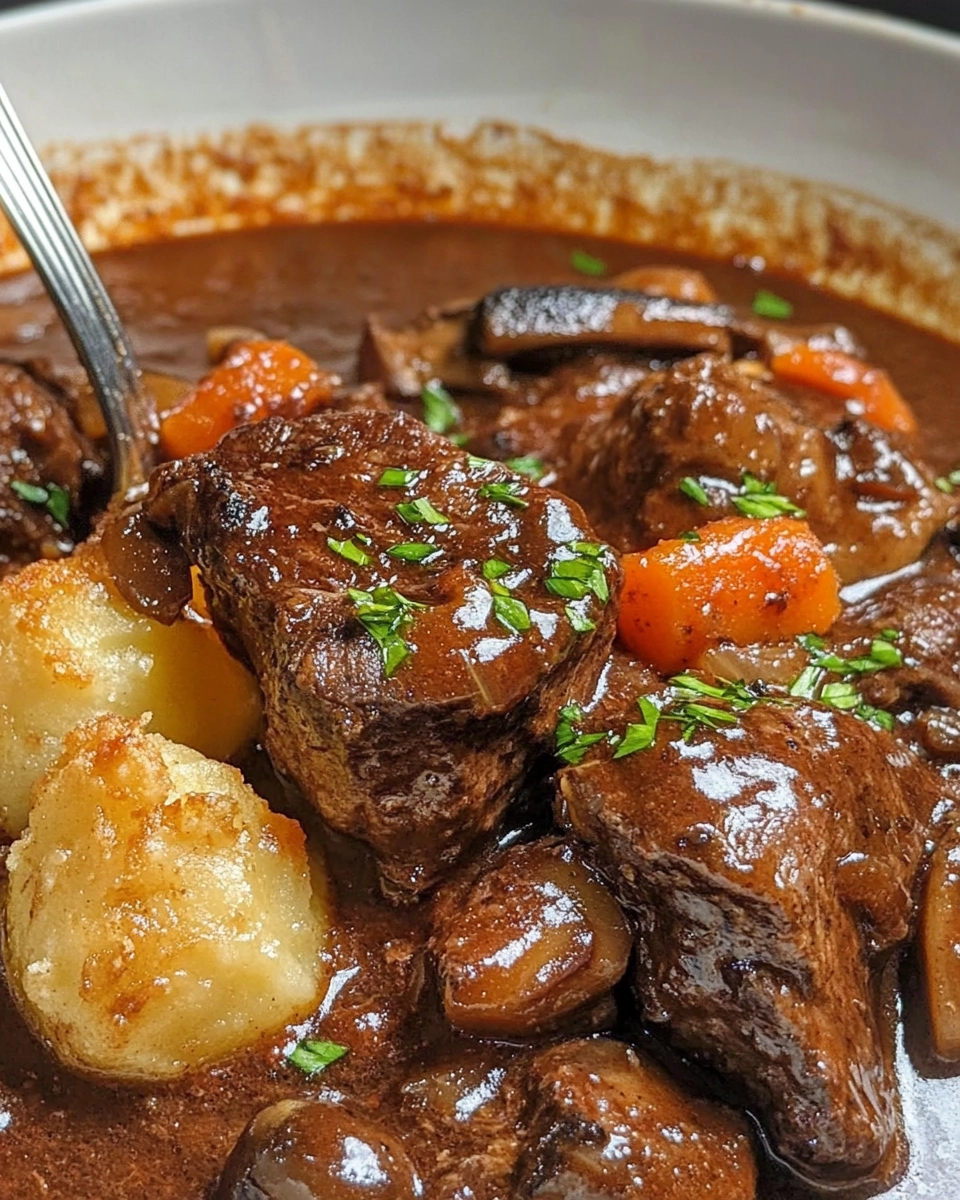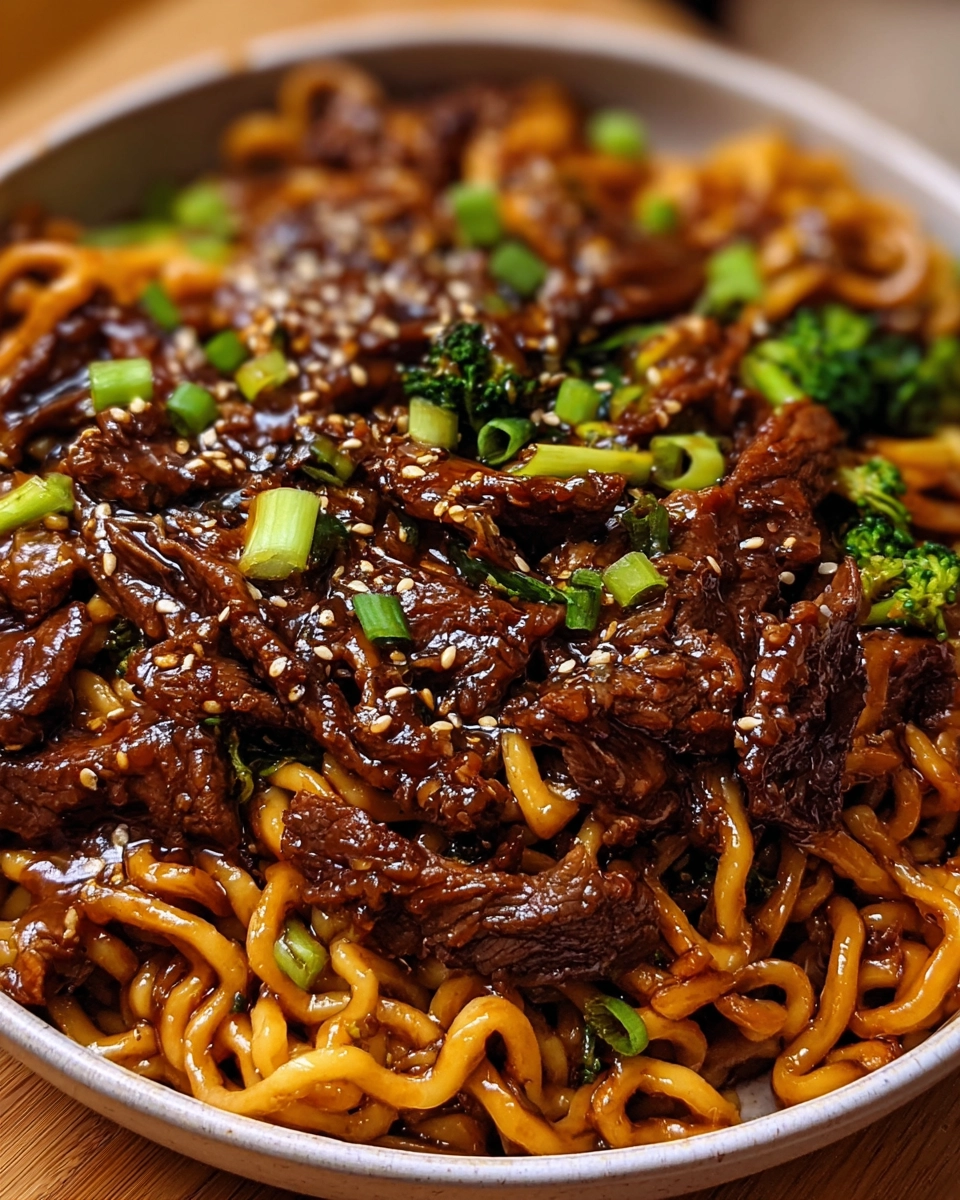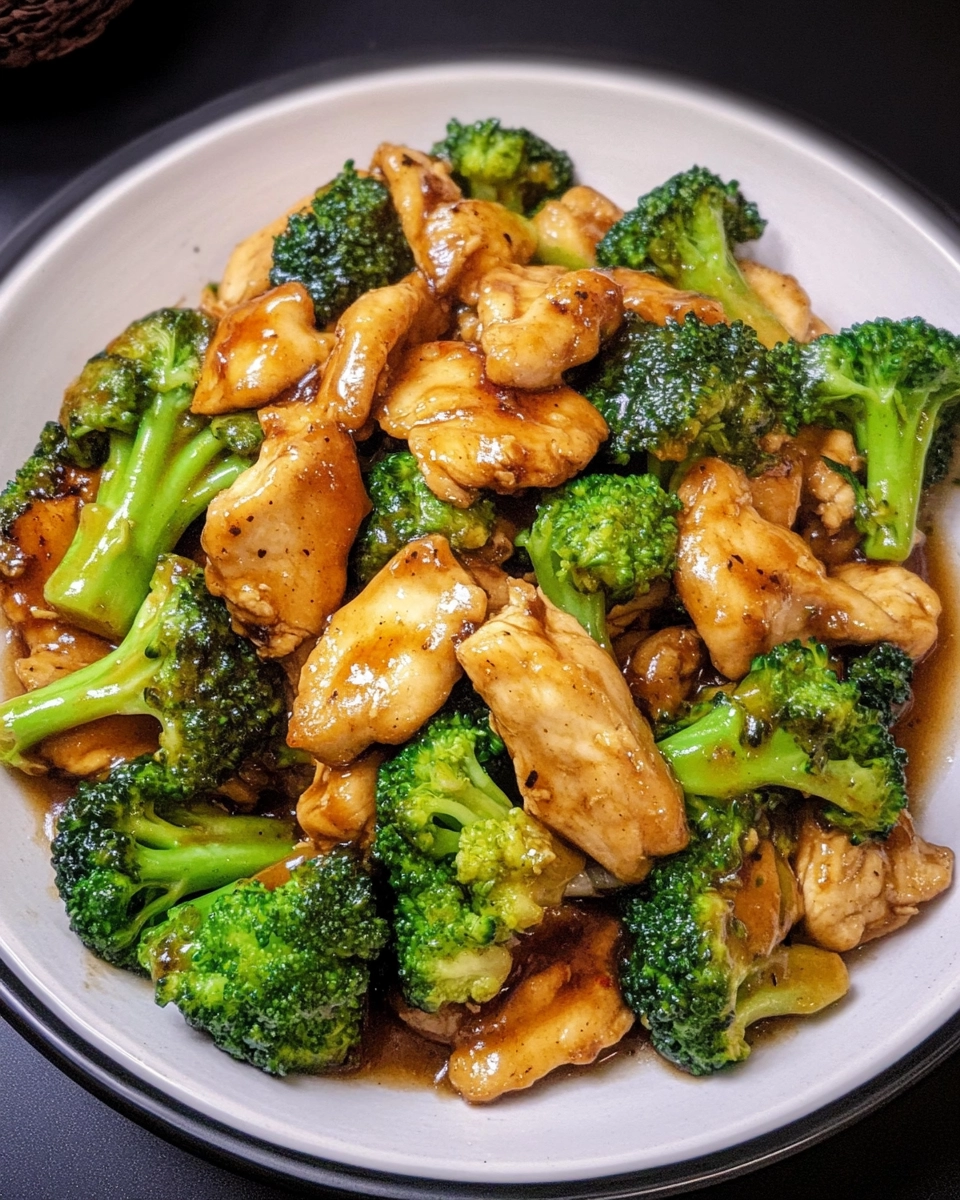Caramelized Korean Beef Bibimbap with Gochujang Aioli Drizzle might sound like something off a trendy NYC food truck, but in my kitchen just outside of Asheville, North Carolina, it’s a weeknight favorite. I’m Maggie Rae Donovan, a 42-year-old home cook with deep Southern roots and a lifelong love of good food. I didn’t train in any fancy culinary school—I trained in real life, with flour-covered counters, overflowing stockpots, and the occasional “oops” that turned into family classics.
My journey started, as many Southern stories do, in my grandmother’s warm kitchen. I was six, standing on a chair while she folded biscuit dough with hands that knew the rhythm of generations. That memory never left me. It taught me that food could be more than sustenance. It could be storytelling, healing, joy, and love, all on one plate.
Over the years, through career shifts, relocations, and raising two daughters, I always came back to cooking. Whether it was stretching a few ingredients into a hearty meal or crafting a full feast for Sunday supper, my kitchen has always been where life slowed down and flavors came alive.
This Korean beef bibimbap recipe was born from that same spirit—simple ingredients, bold flavors, and a whole lot of heart. It combines the deep umami of caramelized beef, the bright heat of gochujang, and a creamy aioli twist that pulls it all together. I like to think of it as Seoul meets Southern comfort.
It’s my favorite kind of cooking—unexpected, soulful, and unforgettable.
Looking for inspiration? Try this flavor-packed fusion: Savory Ground Beef Bell Pepper Stir-Fry
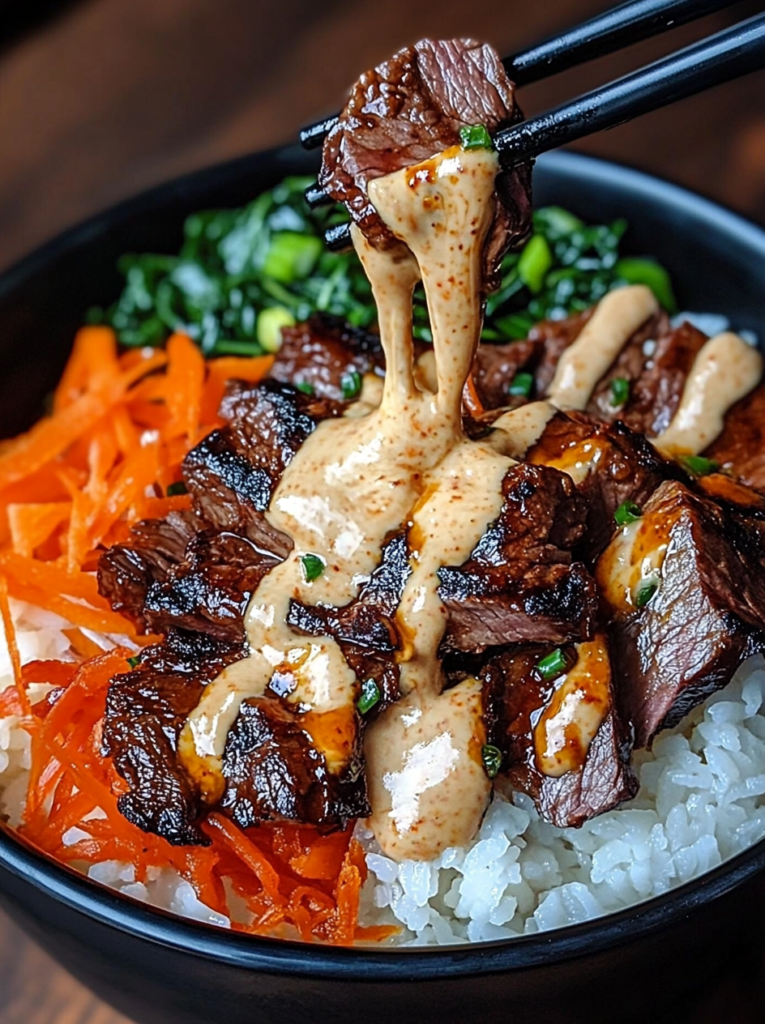
Table of Contents
What is Korean Beef Bibimbap and Why It’s Worth Making
Understanding Traditional Korean Bibimbap
Bibimbap, translating to “mixed rice” in Korean, is a vibrant and nourishing dish packed with color, texture, and flavor. It traditionally consists of warm rice, seasoned vegetables (called namul), thinly sliced beef or pork, a fried or raw egg, and a spicy, slightly sweet gochujang sauce. Everything is arranged beautifully in the bowl before being mixed together just before eating. The result? A perfect bite every time.
Korean bibimbap isn’t just a meal—it’s an experience. Each component plays a role. The crunch of sautéed vegetables, the richness of beef, the creamy yolk from the egg, and the bold zing of gochujang come together to create a dish that’s both comforting and bold.
The Southern Twist: Caramelized Beef and Gochujang Aioli
Here’s where I bring a little Southern soul into this Korean classic. I swap the traditional bulgogi-style beef for deeply caramelized ground beef, seared until it’s crispy around the edges and savory with just a hint of sweetness. I season it with soy, garlic, and a whisper of brown sugar—my nod to Southern barbecue.
And instead of spooning on just plain gochujang, I whip up a luscious gochujang aioli drizzle. It’s smoky, creamy, spicy, and slightly tangy thanks to garlic, lime juice, and a touch of mayo. It mellows the heat just enough while keeping all the punchy flavor you crave in a bibimbap bowl.
If you’ve never tried spicy aioli over rice, let me tell you—it’s a game-changer.
Why This Dish Belongs in Every Home Kitchen
You don’t need specialty tools or a trip to an Asian market to make this work. Most of the ingredients are pantry staples or easy to find at a local grocery store. Bibimbap is also endlessly customizable. Use any veggies you have on hand. Add a fried egg or keep it plant-based. Make it yours.
It’s ideal for meal prep too. Cook everything in batches, store it separately, and reassemble throughout the week. Quick lunches, easy dinners, even make-your-own-bowl nights with kids or guests—it always delivers.
Discover great ideas like Savory Stir-Fried Beef Garlic Soy Bok Choy to level up your flavor game.
Cultural Respect Meets Creative Cooking
As much as I love adding my own twist, I also believe in honoring the roots of this dish. Korean cuisine is about balance—sweet, salty, spicy, sour, and umami all dancing together. In this version, I keep that balance intact while giving it the Southern warmth I grew up with.
So whether you’re a longtime fan of Korean food or just curious about trying something new, this version of Caramelized Korean Beef Bibimbap with Gochujang Aioli Drizzle offers an approachable, flavor-forward way to bring something exciting to your table.
Looking for more inspiration? Don’t miss our Fragrant Slow Cooked Beef Curry Coconut Naan
Essential Ingredients for the Perfect Bibimbap Bowl

The Heart of the Bowl: Steamed Rice
Bibimbap starts with rice, traditionally short-grain white rice that’s sticky enough to hold everything together when mixed. You can use jasmine or sushi rice, but even long-grain or brown rice will work in a pinch. Want to go low-carb? Cauliflower rice is a great substitute too.
Best Rice Choices for Bibimbap:
| Type of Rice | Texture | Best For |
|---|---|---|
| Short-Grain White | Sticky, soft | Traditional bibimbap |
| Jasmine | Fluffy, slightly dry | Mild flavor, good base |
| Brown Rice | Nutty, chewy | Extra fiber, hearty bowl |
| Cauliflower Rice | Light, low-carb | Keto-friendly option |
The Star Ingredient: Caramelized Ground Beef
While traditional bibimbap may use thinly sliced ribeye or bulgogi, I use ground beef because it’s affordable, easy to caramelize, and soaks up bold flavors beautifully. I brown it until crispy, then toss it in a mix of soy sauce, garlic, ginger, brown sugar, and sesame oil. The result? Deep umami with a sweet edge—Southern-style comfort meets Korean punch.
Looking for a beef-forward comfort dish? Check out Mouthwatering Homemade Tuna Melt Patties for another satisfying favorite.
The Supporting Cast: Sautéed and Pickled Veggies
A true bibimbap bowl celebrates vegetables. I like to include a rainbow:
- Julienned carrots, lightly sautéed
- Baby spinach, wilted in sesame oil
- Zucchini, sautéed or spiralized
- Mushrooms, preferably shiitake or cremini
- Kimchi, for a tangy fermented punch
- Cucumbers, quickly pickled in rice vinegar for crunch
Don’t worry if you don’t have them all. Bibimbap is flexible. Leftover roasted veggies? Use them. Fresh garden greens? Toss them in. It’s more about balance than perfection.
The Creamy Kick: Gochujang Aioli
This sauce is where my version really stands out. Traditional gochujang adds spice and depth, but blending it with mayo, lime juice, garlic, and a splash of soy creates a gochujang aioli drizzle that coats every bite like silk. It’s creamy, spicy, tangy, and just a little smoky.
Simple Gochujang Aioli Recipe:
- 3 tbsp mayo
- 1 tbsp gochujang paste
- 1 tsp lime juice
- 1 small garlic clove (grated)
- ½ tsp soy sauce
Whisk it all together and taste. Want it hotter? Add more gochujang. Want it creamier? Add more mayo. You’re the chef.
The Golden Crown: Fried Egg
You can’t skip the egg. Fried until crispy on the edges but soft in the center, it adds richness and makes every forkful more satisfying. Some folks prefer a raw egg yolk for authenticity, but in my kitchen, that sunny-side-up egg with its golden center is non-negotiable.
Extra Toppings that Elevate
Want to go the extra mile? Try adding:
- Sesame seeds for crunch
- Nori strips for a sea-salty edge
- Scallions for brightness
- Toasted sesame oil drizzle for aroma
Even just a little sprinkle of these can make your bibimbap bowl feel restaurant-worthy.
For more cozy beef-based dishes, don’t miss our Rich Creamy Chicken Bacon Mushroom Stroganoff
How to Make Caramelized Korean Beef Bibimbap Step by Step
Step 1: Prep All Your Ingredients Before You Start
Bibimbap comes together fast, so it’s important to prep first. This is your mise en place moment—chop, marinate, and get everything in place. You’ll need:
- Cooked white or brown rice
- Sliced or julienned vegetables
- Ground beef
- Garlic, ginger, soy sauce, sesame oil, brown sugar
- Gochujang, mayo, lime, and garlic for the aioli
- Eggs (one per bowl)
Having all your components ready keeps things smooth—and makes you feel like a pro in your own kitchen.
Step 2: Cook the Rice
If you haven’t already, cook your rice according to the package. For extra flavor, stir in a bit of sesame oil and a pinch of salt while it steams. Keep it warm while you work on the rest.
Step 3: Make the Gochujang Aioli Drizzle
In a small bowl, combine:
- 3 tablespoons mayo
- 1 tablespoon gochujang
- 1 teaspoon lime juice
- 1 minced garlic clove
- ½ teaspoon soy sauce
Whisk until smooth and creamy. Taste and adjust the spice level. Set it aside—it’s going to tie the whole dish together.
Step 4: Sauté the Veggies
In a non-stick pan, add a drizzle of sesame oil and sauté your veggies separately:
- Carrots: sauté 2–3 minutes until just tender
- Spinach: cook until wilted (1–2 minutes)
- Mushrooms: brown for 4–5 minutes
- Zucchini: cook lightly to retain a little crunch
This way, each veggie keeps its own flavor and texture.
Step 5: Caramelize the Beef
In the same skillet, heat a tablespoon of oil. Add the ground beef and let it brown without stirring for the first 2–3 minutes. Then, break it up and cook until most of the moisture evaporates and it’s deep brown and crispy.
Add:
- 2 tablespoons soy sauce
- 1 teaspoon brown sugar
- 1 teaspoon sesame oil
- 1 teaspoon grated ginger
- 2 cloves garlic, minced
Cook another 1–2 minutes until everything is glossy and fragrant.
Looking for another caramelized flavor bomb? Don’t miss our Caramelized Spicy Garlic Chicken Ramen.
Step 6: Fry the Eggs
Heat oil in a small pan and fry your eggs sunny-side up. You want crisp edges and soft yolks that will ooze into your bowl when you dig in. Sprinkle with a little salt and pepper.
Step 7: Assemble Your Bibimbap Bowl
In each bowl, layer:
- A scoop of warm rice
- Neat piles of each veggie
- A generous spoonful of caramelized beef
- One fried egg
- Drizzle gochujang aioli over the top
- Garnish with sesame seeds, scallions, and optional nori strips
Mix it all up before eating—and savor every bite.
Step 8: Serve and Enjoy Immediately
Bibimbap is best hot and fresh. Serve with extra gochujang or aioli on the side, and maybe even a cold cucumber salad for contrast.
Looking for more fusion-style comfort food? Don’t miss our Savory Onion Beef Fried Rice with Tender Beef Strips
Customizing Bibimbap to Fit Any Diet or Lifestyle
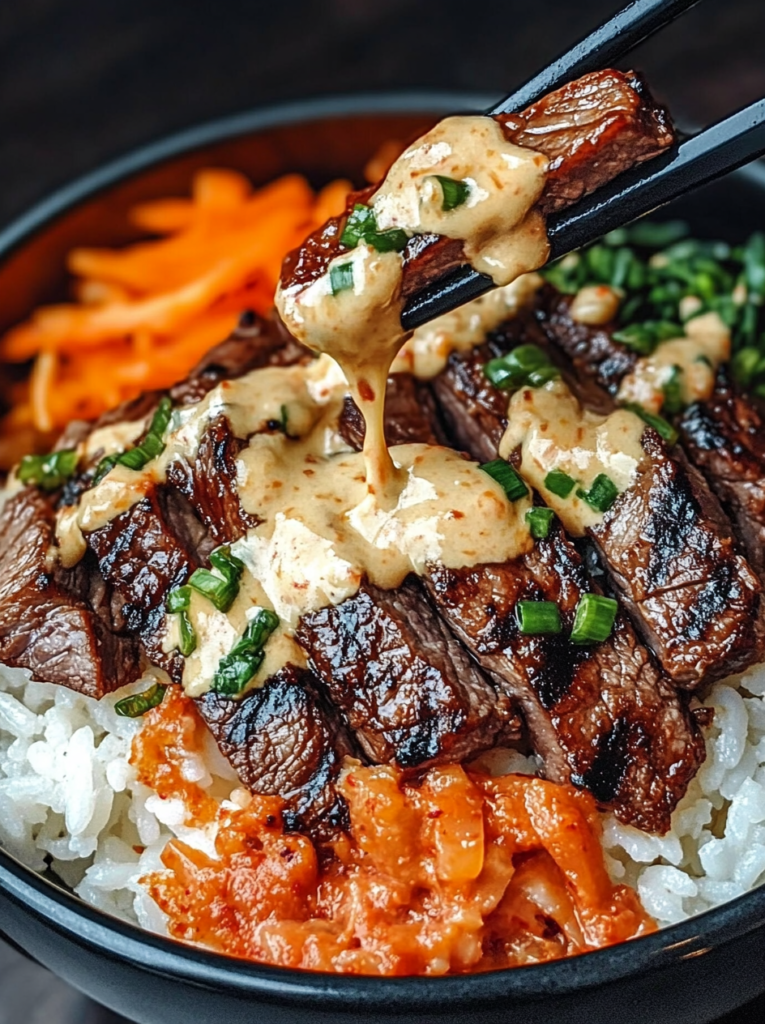
Going Vegetarian or Vegan? Here’s How to Keep It Bold
Bibimbap is one of the easiest dishes to turn vegetarian or vegan while keeping it satisfying. The core idea—rice, veggies, sauce—stays the same. All you need to do is swap the beef and the egg.
Meatless Alternatives for the Beef:
- Crispy tofu, pan-fried with soy, garlic, and sesame oil
- Mushroom medley, sautéed and caramelized with similar seasonings
- Tempeh, crumbled and marinated for a nutty, high-protein base
- Lentils, cooked until slightly firm and sautéed in gochujang and garlic
Instead of egg, try:
- A dollop of vegan mayo mixed with gochujang for richness
- Roasted chickpeas for crunch
- A drizzle of tahini with garlic and chili for creaminess
The gochujang aioli is already adaptable. Swap mayo with vegan mayo and boom—you’ve got a spicy, plant-based drizzle that still delivers.
Making It Gluten-Free
Most of bibimbap is naturally gluten-free. The culprits are often:
- Soy sauce (replace with tamari or coconut aminos)
- Gochujang (some brands contain wheat; use a certified gluten-free version)
Everything else—rice, veggies, eggs, beef—is fair game.
Need another gluten-free comfort dish idea? Check out our Cottage Cheese Spinach Crustless Quiche
Low-Carb & Keto-Friendly Adjustments
Want to enjoy bibimbap while staying low-carb? No problem. Here’s how:
- Use cauliflower rice instead of white rice
- Skip the sugar in the beef marinade or use a keto sweetener like monk fruit
- Add more fats with avocado slices or a drizzle of sesame oil
- Load up on low-carb veggies like spinach, mushrooms, and zucchini
Bibimbap isn’t just delicious—it’s flexible enough to support your health goals.
High-Protein Power Bowl
Looking to bulk it up post-workout or for a more filling meal? Try this:
- Double the beef or use lean ground turkey or chicken
- Add a second egg or a hard-boiled egg chopped on top
- Include edamame or black beans
- Top with Greek yogurt gochujang sauce for a protein boost
This way, you’re not just eating something tasty—you’re eating smart.
For the Picky Eaters
Got kids or picky eaters in the house? Serve this deconstructed:
- Rice in one section
- Veggies separate (let them pick favorites)
- Gochujang aioli on the side for dipping
- Mild beef with less spice
It makes dinner fun and interactive—plus, it helps build their flavor confidence over time.
The Cultural Roots Behind Bibimbap and Gochujang
A Dish Born from Harmony and Balance
Bibimbap is more than just a colorful rice bowl—it’s a deeply symbolic dish that reflects Korean cultural values. At its heart, bibimbap is about balance and unity. Each element represents different aspects of nature and health:
- Rice represents the Earth
- Vegetables symbolize seasons and color balance (white, yellow, green, red, and black)
- Protein (meat or egg) brings strength
- Gochujang offers heat, vitality, and depth
When mixed together, these components symbolize harmony in life. That’s why bibimbap is traditionally served unmixed—until the eater brings it together. It’s a moment of mindfulness.
Origin of Bibimbap: From Humble Leftovers to National Pride
Bibimbap has its roots in frugality and practicality. Originally called goldongban, it was created as a way to use leftover banchan (side dishes). Over time, it became a culinary staple, especially in the Jeonju region, where bibimbap is served with raw beef, a dozen toppings, and sesame-scented rice.
Today, bibimbap is served everywhere from humble street stalls to fine-dining restaurants. It’s recognized worldwide as one of Korea’s signature dishes, celebrating both variety and simplicity.
What Is Gochujang and Why Is It So Important?
Gochujang is a fermented red chili paste made from chili powder, glutinous rice, fermented soybeans, and salt. It’s spicy, sweet, and savory all at once. Fermentation deepens the flavor and creates umami-rich complexity.
Historically, gochujang was homemade and aged in clay pots under the sun. Families would pass down their methods, and the paste was used not just for flavor—but as a way to preserve and energize meals through long winters.
Today, it’s the backbone of Korean cooking. From stews to marinades to dipping sauces, gochujang is everywhere—and it’s the spark that brings bibimbap to life.
Want more bold, saucy inspiration? Discover great ideas like Savory Fried Cabbage with Crispy Bacon, Sweet Onions, and Garlic.
Korean Aioli? A Modern, Global Twist
Traditional Korean cuisine doesn’t include aioli, but this creamy addition brings a modern fusion that works beautifully with bibimbap. My version of gochujang aioli mixes global textures with Korean heat—creating a sauce that’s as good drizzled on roasted veggies as it is over rice.
It reflects how food evolves—honoring its roots while adapting to new tastes, tools, and stories. And honestly? Once you try it, you’ll be looking for other ways to use it.
How to Prep, Store, and Reheat Bibimbap for Busy Weeks
Why Bibimbap Is the Perfect Make-Ahead Meal
Life gets hectic—between work, kids, and just trying to keep your house standing, the last thing anyone wants to do is make a complicated dinner from scratch every night. That’s where bibimbap shines. It’s a perfect prep-ahead meal because all the components store well separately and come together in minutes when you’re ready to eat.
You get variety, nutrition, and that satisfying “I cooked something real” feeling—without the midweek stress.
Smart Prep Strategy: Batch Cooking Bibimbap
You don’t need to make a full bibimbap bowl every time. Prep each layer in advance and store them in containers. Here’s how to do it like a pro:
1. Rice
- Make a big batch of short-grain or jasmine rice
- Store in airtight containers or freezer bags
- Reheat with a splash of water in the microwave to restore fluffiness
2. Caramelized Beef
- Cook the beef completely, then cool
- Store in the fridge up to 4 days or freeze for 2 months
- Reheat in a skillet to maintain texture and caramelization
3. Sautéed Veggies
- Store veggies in individual containers to keep flavors distinct
- Spinach, carrots, mushrooms, and zucchini all last 3–4 days refrigerated
- Kimchi should always be stored in its original container and keeps much longer
4. Gochujang Aioli
- Whip up a jar and keep it sealed in the fridge
- Lasts up to 1 week
- Stir before each use—natural separation may occur
Pro Tip: Make it ahead on Sunday, and you’ll have 3–4 bowls ready to go throughout the week.
Need a side dish that keeps well too? Don’t miss our Fresh Pickled Cucumber Salad for a crunchy, refreshing addition.
Easy Reheat and Assembly Guide
- Warm the rice with a splash of water
- Reheat the beef in a skillet
- Lightly warm or leave veggies at room temp
- Fry a fresh egg (optional but recommended)
- Drizzle with gochujang aioli
- Garnish and mix just before serving
If you’re packing lunch for work, leave off the egg and pack the sauce separately to avoid sogginess. At lunchtime, microwave for 1–2 minutes, mix, and dig in.
Bibimbap Bowl Kits: A Weeknight Hack
Want to make it even easier? Create DIY bibimbap bowl kits in meal prep containers:
- Bottom layer: rice
- Side compartments: beef, veggies
- Small lidded cup: gochujang aioli
- Add egg fresh or use a hard-boiled one
Just like that, you’ve got fast food—but made at home and bursting with flavor.
PART 8: Nutritional Benefits of Bibimbap with Gochujang Aioli
A Balanced Bowl with Real Food Fuel
One of the most beautiful things about bibimbap is how nutritionally balanced it is by design. It brings together carbs, protein, healthy fats, and a rainbow of vegetables, all in one hearty bowl. When made with quality ingredients, this dish isn’t just tasty—it’s smart eating.
Whether you’re focused on fuel for energy, macro tracking, or just want to feed your family well, this bowl checks all the boxes.
Macronutrient Breakdown (per serving, estimated)
| Nutrient | Approx. Amount |
|---|---|
| Calories | 550–650 kcal |
| Protein | 22–30g |
| Carbohydrates | 45–55g |
| Fats | 25–30g |
| Fiber | 5–7g |
This range depends on portion size, beef-to-veggie ratio, and how generous you are with the aioli (no judgment!).
Want more cozy, nutrient-dense meals? Try our Spinach Feta Quiche with Sweet Potato Crust
Nutritional Highlights
High in Protein
Thanks to the caramelized beef and the fried egg, each bowl delivers plenty of protein. Want more? Add extra egg whites or top with sesame seeds for a plant-protein punch.
Full of Fiber and Antioxidants
With spinach, carrots, zucchini, mushrooms, and kimchi, you’re getting a powerful dose of vitamins A, C, K, along with antioxidants and gut-friendly fiber. The variety of colors in the bowl means you’re also tapping into the phytonutrient spectrum.
Healthy Fats
Sesame oil and gochujang aioli bring in heart-healthy fats. If you’re following a higher-fat diet, you can add avocado or top with a drizzle of extra virgin olive oil.
Gochujang’s Hidden Benefits
Did you know that gochujang, thanks to its fermentation, may support gut health and digestion? It’s also rich in capsaicin, which can help rev up metabolism and reduce inflammation when consumed regularly in small amounts.
Lighten It Up or Power It Up
- To make it lighter: use lean ground turkey or chicken, cut back on rice, and use low-fat Greek yogurt in place of mayo for the aioli.
- To power it up: double the veggies, use whole grains like brown rice or quinoa, and add an extra egg or a scoop of edamame for more plant protein.
Great for Meal Plans
This bibimbap bowl fits a variety of eating plans:
- Low GI (especially with brown rice or cauliflower rice)
- High protein diets
- Vegetarian (with swaps)
- Dairy-free
- Balanced eating approach
So whether you’re meal prepping for energy, flavor, or fitness, bibimbap is more than delicious—it’s purposeful food.
Final Thoughts and Serving Tips
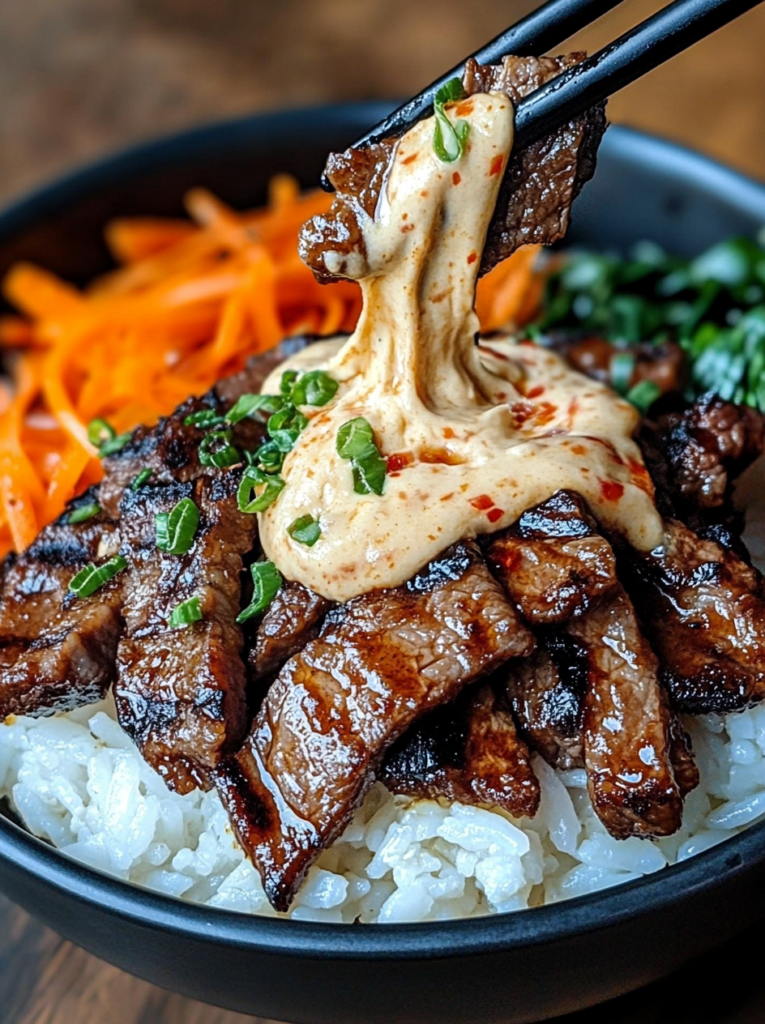
Caramelized Korean Beef Bibimbap with Gochujang Aioli Drizzle: A Bowl Full of Comfort and Bold Flavor
If you’ve been craving a dish that delivers deep comfort, bold flavor, and flexible prep, look no further than Caramelized Korean Beef Bibimbap with Gochujang Aioli Drizzle. It blends the soul of Korean tradition with the warmth of Southern cooking—making it personal, nostalgic, and entirely craveable.
What started as a humble bowl of rice and vegetables is now a global favorite—and for good reason. Bibimbap offers something different in every bite. Whether you’re spooning up creamy gochujang aioli, digging into crispy beef, or savoring the richness of a runny egg, this dish is a reminder that home cooking can be simple and special at the same time.
Don’t forget—this recipe can be adapted for any lifestyle. From plant-based eaters to meat lovers, from quick lunches to beautiful dinner bowls, it’s an invitation to eat well, experiment with flavor, and enjoy the process.
So go ahead—mix it up, share it with someone you love, and maybe drizzle on just a little extra sauce for good measure.
Want More Recipe Inspiration?
- Looking for another Asian fusion idea? Check out our Caramelized Spicy Garlic Chicken Ramen
- Discover great ideas like Savory Stir-Fried Beef Garlic Soy Bok Choy
- Don’t miss our Fragrant Slow Cooked Beef Curry Coconut Naan
- Looking for inspiration? Try Savory Ground Beef Bell Pepper Stir-Fry
PART 7: Frequently Asked Questions About Bibimbap and Gochujang Aioli
What is Korean bibimbap made of?
Traditional Korean bibimbap is made of steamed white rice, a variety of sautéed and seasoned vegetables (like spinach, bean sprouts, mushrooms, and carrots), sliced or ground beef, and a fried or raw egg on top. It’s served with gochujang, a fermented red chili paste, that brings spice and depth.
The dish is usually arranged in neat sections in the bowl and mixed just before eating—hence the name bibimbap, meaning “mixed rice.”
In our twist, we use caramelized ground beef and a creamy gochujang aioli drizzle to deliver bold flavor in every bite.
Don’t miss our creative twist on this with Savory Potato Cakes Filled With Cheesy Beef.
What does bibimbap taste like?
Bibimbap tastes like balance in a bowl. You get warmth from the rice, umami and savory notes from the beef, slight bitterness and sweetness from the veggies, the rich creaminess of egg, and the bold spice of gochujang.
It’s spicy, salty, slightly sweet, and earthy all at once—with every bite being just a little different, depending on what you mix together. When you add gochujang aioli to the mix, you get a smoky, tangy creaminess that rounds out the heat.
It’s like comfort food with layers—warm, complex, and totally crave-worthy.
What is gochujang for bibimbap?
Gochujang is a fermented Korean chili paste made from red chili powder, glutinous rice, fermented soybeans, and salt. It has a thick, sticky texture and offers spicy, sweet, and umami-rich flavors.
In bibimbap, it acts as the main sauce—bringing the heat and depth that ties the entire bowl together. Some people mix it directly with rice, others add it on top and blend while eating.
In this recipe, we elevate gochujang by turning it into an aioli—adding mayo, garlic, lime juice, and soy sauce for a velvety, punchy drizzle that makes each forkful unforgettable.
What is Korean aioli?
While aioli originates from Mediterranean cuisine, Korean-inspired aioli is a fusion creation. In our version, it’s a creamy sauce made with mayo and gochujang, balanced by fresh lime juice and minced garlic.
It combines the heat of Korean chili paste with the smooth richness of mayo—ideal for bibimbap, burgers, grain bowls, or even as a dipping sauce for fries.
Think of it as your new favorite spicy comfort condiment.
